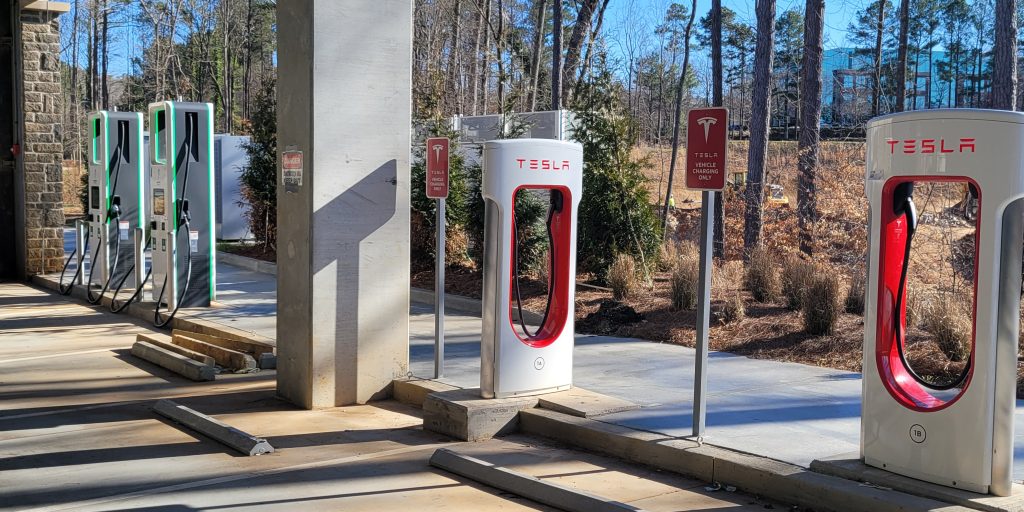Cities steadily adding more EV chargers for public to use
Local governments are making headway as they develop their electric vehicle (EV) infrastructure. “Progress varies depending on what stage governments are at in the electrification strategy and funding availability,” says Brandon Branham, assistant city manager and chief technology officer for Peachtree Corners, Ga., which is part of the Atlanta metro. Its 2022 population is estimated at 45,099.
Branham’s community has been working on its electrification strategy for the past seven years. It installed its first public charging infrastructure in 2014, only two years after incorporation as a municipality. “Since then, the city has gone onto testing roadway applied, solar-powered EV charging and it has expanded the public charging network throughout the city. We have released an RFP to establish a buying program of EV infrastructure for our residents and business communities.” Branham adds that Peachtree Corners is working on establishing a private-public partnership to open the largest Direct Current Fast Charge (DCFC) charging site in metro Atlanta.
Branham spotlights one trend: “We have seen a steady pace of EV infrastructure being deployed by local governments over the past 10 years. A majority of those are in higher EV-car-sales states, such as California.” He adds, however, that the landscape is rapidly changing. “Local governments are seeing the need for this infrastructure as more and more car manufacturers are producing electric vehicles.”
Last month, Lakewood, Ohio (2022 population, 48,676; it’s part of the Cleveland metro) began collecting an EV charging fee of 24 cents per kilowatt-hour (kWh) at its seven stations located throughout the community. EV drivers had been getting a free charge when powering up at one of the city’s many charging stations.
The fee will enable the city to not only sustain but also shift to new equipment as the old chargers age. “The EV charging rate will enable us to recover our costs in time and in administrative management, but also when these chargers become obsolete or no longer work after five or 10 years, that we have funds available to pull from to put a new charger in to replace it,” Lakewood Mayor Meghan George told Cleveland.com.
“It’s no benefit to the EV community or for all of us who want to be greener if we don’t have the built-in infrastructure to make sure it’s maintainable,” the mayor added. “As we continue to put more and more electric vehicle charging stations into our community, it’s important that we’re planning for the future.”
With the new fee, the city expects to break even with its electricity bill on its charging activity. Lakewood also imposes an idle toll on the chargers, which have time limits posted on signage. At the city’s (level 3) DC chargers the time limit is two hours and for the level 2 chargers it’s four hours. If motorists leave cars past the time limit and occupy the space, they will be charged $2 per hour. The idle fee will hopefully encourage as well as reinforce appropriate behavior for public charging so other people can use the equipment.
EV charging station manufacturer ChargePoint is the vendor that provides the EV chargers in Lakewood. Fees are imposed through the firm’s app.
Advice for local government administrators
Partnering with a company that can work with multiple vendors can be critical to leveraging all the components associated with acquiring and operating EV charging stations, says Barry Carr, director, business development – eMobility and electrical infrastructure at ABM. The company is a facility management provider and offers facility solutions. It provides a variety of services in each industry it serves.
“Many vendors can’t, or won’t work with each other, so having a partner that is closely matched to the end users’ fleet will ensure interoperability. Todays’ EVs all have different charging profiles; so, it is imperative that both the types of vehicles and the fleets’ operation are matched to the proper EV charging station,” Carr explains.
He points out that a partner that has relationships with multiple charger manufacturers allows them to offer the better overall value and performance for the fleet today and into the future. “It may be that some government fleets will require different charger vendors; but it is imperative that these chargers all utilize open software protocols to allow different vendors to communicate with each other.”
Carr concludes: “ABM has provided custom applications based on the needs of the fleet user. Allowing the EV chargers to be open to the public and to employees will make utility and government funding available to offset the costs.”
Local and state governments that are thinking of acquiring EV charging stations for agency fleet use or public use should reach out to energy providers, says Patricia Taylor, senior manager, regulatory policy and business programs at the American Public Power Association (APPA). The group is the voice of not-for-profit, community-owned utilities that power 2,000 towns and cities nationwide.
“We recommend that local and state governments talk to utilities early and often about charging infrastructure deployment. This provides an opportunity for the utility to educate stakeholders on processes, timeframes, rate options, incentives, pilot programs and any other relevant offerings.” Taylor adds that utilities can provide technical expertise and help with future-proofing charging infrastructure assets.
Governments may need to pump the brakes on investing in EV charging infrastructure, says Tim Sylvester, founder and CEO of smart infrastructure technology provider Integrated Roadways. The firm works to transform America’s network of roadways into self-sustaining smart roads that support the current and future needs of drivers, businesses, vehicles and devices.
“It’s not feasible to continue adding more expectations to limited local government budgets, especially when existing expectations for public infrastructure are widely unmet and underserved. Local and state governments need to step aside and let private companies provide upgrades, operate the charging systems, assess fees for the use of charging gear, and use those fees to fund the improvements to the roads,” Sylvester tells American City & County.
This strategy delivers good outcomes, Sylvester explains. “The government gets ‘free’ road upgrades they can’t otherwise afford, incentivizes the use of cleaner, more efficient vehicles, and every single mile of road that’s upgraded this way is one less mile of road for the government to maintain with its limited budgets. This is a win-win approach for everyone involved and the best possible way for public agencies to support the adoption of EV charging.”
What the future holds
Look for an acceleration of EV adoption as pickups, vans and buses hit the EV market, along with passenger cars, says Desmond Wheatley, CEO of Beam Global. The firm is a clean technology enterprise that providing sustainable products and technologies for the electrification of transportation and energy resiliency.
“EV charging infrastructure deployments will become more urgent as more EVs join fleets. There will be more mandates driving electrification and more recognition by fleet operators that EVs offer a lower total cost of ownership already,” Wheatley tells American City & County. He predicts more dollars to build out EV charging operations will be available as federal and state funds are distributed.
“Fleet operators will increasingly seek EV charging infrastructure that will continue to operate during blackouts and also during network outages. Utilities will be pushed to recognize a lack of capacity on the grid and offer time frames to address these shortfalls,” Wheatley adds. His belief, however, is that those timeframes will not meet the needs of the fleet operators who will select alternate means of electricity provision.
Vehicle electrification objectives are going to be more deliberate and goal-oriented to meet clean air targets and reduce greenhouse gasses, predicts Ron Stupi, senior vice president and COO, building and infrastructure at Bureau Veritas. The company provides testing, inspection and certification services globally. Bureau Veritas has developed an electric vehicle charging team and continues to invest to be a strategic partner of EV charging deployments worldwide.
Stupi explains that in the past, a few token zero-emission vehicles (ZEV) were added to a government fleet in order to check the box. “However, now there are mandated goals in place to meet clean air targets. The implementation of EV fleets will be designed to meet those goals today and in the future.”
Vehicle charging within buildings could be key in the transition to EVs, predicts Luis D’Acosta, executive vice president of the digital energy global division at Schneider Electric. The firm drives digital transformation by integrating process and energy technologies to realize the full efficiency and sustainability opportunities for organizations.
“The rise of electrical vehicles ultimately reveals an opportunity for electrification to transform buildings to not only be a place where cars are parked, but also a place that will replenish them with energy,” D’Acosta says. He notes, however, that placing EV charging stations within buildings creates new challenges for building owners, such as increased need for electricity. “It will motivate many to invest in digital energy management capabilities as buildings will need up to 40 percent more electricity to handle EVs alone.”
D’Acosta explains that the upward march of EV adoption mirrors the path of renewables. “Most of the environmental benefits of EVs rely on cars powering through clean energy sources. Buildings play a significant role in the renewable energy future by producing cheap solar power to mitigate consumption costs and climate impact.”
Recent American City and County posts show how procurement officers lead the way in EV charging infrastructure and a public-private partnership serves as a tool for EV infrastructure.
Michael Keating is senior editor for American City & County. Contact him at [email protected].




















